|
|
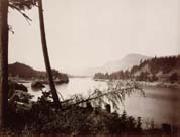 |
Carleton E.Watkins
|
|
American photographers , b. 1829, d. 1916
was a noted 19th century California photographer. Carleton Emmons Watkins was born in Oneonta, upstate New York. He went to San Francisco during the gold rush, arriving in 1851. He traveled to California with Oneontan Collis Huntington, who later became one of the owners of the Central Pacific Railroad, which helped Watkins later in his career. His interest in photography started as an aide in a San Francisco portrait studio, and started taking photographs of his own in 1861. He became interested in landscape photography and soon started making photographs of California mining scenes and of Yosemite Valley. He experimented with several new photographic techniques, and eventually favored his "Mammoth Camera," which used large glass plate negatives, and a stereographic camera. He became famous for his series of photographs and historic stereoviews of Yosemite Valley in the 1860s, and also created a variety images of California and Oregon in the 1870s and later. Watkins purchased the 1860s Central Pacific Railroad construction stereoview negatives from CPRR official photographer Alfred A. Hart and continued their publication through the 1870s. However Watkins was not a good businessman. He spent lavishly on his San Francisco studio and went deeply in debt. His photographs were auctioned, following a business setback, resulting in his photographs being published without credit by I. W. Taber, the new owner. Watkins also had problems of his photographs being reprinted without permission by Eastern companies and with other photographers rephotographing the exact scenes Watkins photographed. In 1879, Watkins married his 22-year-old assistant, Frances Sneade, with whom he had two children. Watkins began anew with his "New Series," which included a variety of subjects and formats, mostly related to California. |
|
|
|
|
|
 |
charles emile callande
|
|
1797-183
Charles-Emile-Callande de Champmartin (Bourges, 1797 -Paris,1883) was a French painter.
His numerous portraits, historical and religious pictures were very popular. |
|
 |
Charles Lock Eastlake
|
|
English Painter, 1793-1865
English painter, museum director, collector and writer. Fourth son of an Admiralty lawyer at Plymouth, he was educated at local grammar schools and then, briefly, at Charterhouse, Surrey. Determined to become a painter, he began work in 1809 as Benjamin Robert Haydon's first pupil and as a student at the Royal Academy Schools in London. In 1815 he exhibited for the first time at the British Institution, visited Paris and studied the pictures in the Musee Napoleon. He achieved his first conspicuous success with a scene from contemporary history that he had himself witnessed, |
|
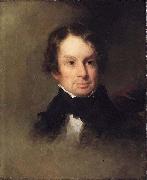 |
Charles Loring Elliott
|
|
1812-1868.
Elliott was born at Auburn, New York in the central part of the state. He began working as a painter in his region. After 10 years, he moved to New York City to study art under the painters John Trumbull and John Quidor, as well as to be in a bigger market for work.
After practicing portrait painting in central New York State for 10 years, Elliott took up residence in New York City in 1845. The following year he was elected to the National Academy of Design, which was a measure of recognition and helped him attract more clients.
Painting by Elliott of Samuel Putnam Avery, 1863Elliott was considered the best portraitist of his day. Although he never studied abroad, his technique is neither provincial nor uncertain. His method is mature, his drawing firm, his color fresh and clean, and his likenesses excellent, though somewhat lacking in sentiment.[citation needed] He was said to have painted over 700 portraits, mostly heads, as he had little idea of the composition of large canvases. He also painted figure pieces, including Don Quijote and Falstaff, and one landscape, The Head of Skaneateles Lake. |
|
|
|
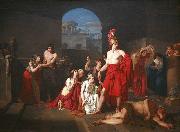 |
Charles-edouard Chaise
|
|
(1759, Paris - 1798, Fontainebleau) was a French neoclassical painter.
His father was a painter, art dealer and member of the Academie de Saint-Luc. Charles-Edouard studied under Jean Bonvoisin in 1775, then under Jean-Jacques Lagrenee, before winning second prize in the 1778 prix de Rome with David condemning to death the Amalekite bringing him Saul's diadem.
|
|
|
|
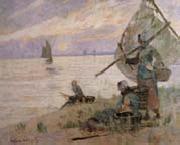 |
Chigot Eugene
|
|
French history painter and marine specialist , 1860-1890
|
|
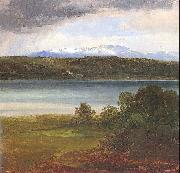 |
Christian Ernst Bernhard Morgenstern
|
|
(29 September 1805 - 12 Februar 1867) was a German landscape painter. Morgenstern is regarded as one of the pioneers in Germany of early Realism in painting. He gained this reputation in Hamburg 1826-1829 together with his contemporary Adolph Friedrich Vollmer while both were still studying; from 1830 onwards, Morgenstern, together with Friedrich Wasmann, Johan Christian Dahl and Adolph Menzel, introduced Munich to Realist painting.
Morgenstern was born in Hamburg as one of six children to a painter of miniatures, Johann Heinrich Morgenstern (1769-1813). After the early death of his father he was placed as an apprentice in the graphic workshop of the brothers Suhr. Cornelius Suhr took the young Morgenstern as his servant on a two-year journey through Germany to publicise the panorama prints which the brothers Suhr produced. 1822 followed another long journey to St. Petersburg, where they stayed for a year and to Moscow. On their return to Hamburg Morgenstern succeeded in leaving Suhr (Vollmer took his place). He became a student of the Hamburg painter Siegfried Bendixen with whom he stayed from 1824 to 1827, then continued his studies at the Royal Danish Academy of Fine Arts in Copenhagen (1827-1828) and undertook study journeys through Sweden and Norway. Bendixen introduced him to the wealthy aristocrat and supporter of the arts, Carl Friedrich von Rumohr, patron to many young Hamburg artists, on whose estate in Holstein he spent several summers. In 1830 Morgenstern went to Munich on Ruhmor's advice. He settled there permanently while undertaking extensive yearly study trips: for the first years through Bavaria, then in the summer of 1836 and in the following summers to the Alsace as guest of a patron of the arts. The winter 1839/40 he returned to Hamburg to stay with his mother. In 1841 he visited Venice and Trieste together with the landscape painter Eduard Schleich and in 1843, and again in 1846 the central Alps. In the summer of 1850 he stayed on Heligoland. |
|
|
|
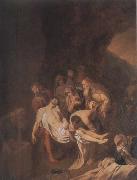 |
Christian Wilhelm Ernst Dietrich
|
|
German Painter, 1712-1774,German painter and etcher. He received his first training from his father, Johann Georg Dietrich (1684-1752), a court painter at Weimar, and was sent to Dresden at the age of 13 to study under the landscape painter Johann Alexander Thiele (1685-1752). In 1728 they travelled to Arnstadt to paint landscapes for stage sets. In 1730 Thiele presented his pupil to Frederick-Augustus I, Elector of Saxony, as a prodigy; Frederick-Augustus appointed him court painter and entrusted him to his minister Heinrich, Graf von Brehl, for whom he worked on some decorative paintings. From 1732 he used the name 'Dietricy' to sign his paintings. He travelled in Germany from 1734 and may have visited the Netherlands, the source of his artistic inspiration. He returned from his travels in 1741 and was appointed court painter to Frederick-Augustus II, Elector of Saxony, who sent him to Italy in 1743 to study. He visited Venice and Rome but returned to Dresden in 1744. |
|
 |
Christoffer Wilhelm Eckersberg
|
|
Danish Neoclassical Painter, 1783-1853
Danish painter and teacher. He has been called 'the father of Danish painting' because of the influence he exerted on Danish painters in the second quarter of the 19th century. With Christen K?bke he was the leading painter of the Danish 'Golden Age' (c. 1800-1850). |
|
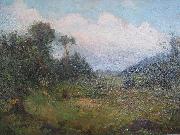 |
Creator:Edmond Dyonnet
|
|
He was born on 25 June 1859 in Crest (Drôme), France, from the marriage of Ulysses-Alexandre Dyonnet, industrialist, and Goullioud Albine. The real family name is Guyonnet de Pivat but due to an error of births during the French Revolution, the surname became Dyonnet. Edmond died in Montreal on 7 July 1954, at age 95. He was buried with his family in the cemetery of Notre-Dame-des-Neiges, in Montreal.
Edmond had two younger sisters, Emma Dyonnet, wife Lorin (1866-1947) and Clemence Dyonnet, wife Chabot (18? -1905). Ulysses, the father of Edmond, had an older brother Leon Dyonnet Goullioud who married Helen, the sister of Albine. Leon Dyonnet made a fortune in corsets for women in association with Amyot from 1886 to 1891 and set up the Dominion Corset company, rue de la Couronne in Quebec City. The couple had a daughter artist, cousin of Edmond Dyonnet: Eugenie Dyonnet, who immigrated to Canada in 1872 and died in 1875 in Montreal.
Edmond Dyonnet was born in Drôme in 1859, and at 9 years old, he followed his father and migrated to Italy, he continued his primary education in Turin, from 1868 to 1873, in municipal schools and then returned to France with his family in the Drôme. He studies at Crest high school from 1873 to 1875. His father Ulysses met in Paris the brother of Judge George Baby who convinced him to emigrate to Quebec.
|
|
 |
David Klocker Ehrenstrahl
|
|
German, 1629-1698,Swedish nobleman and portrait painter who in 1652, at twenty-four years of age, at the request of Carl Gustaf Wrangel, moved to Skokloster Castle, from his art studies in the Netherlands. Between 1654 and 1661 he studied in Italy and visited the courts of both France and England. On his return he became entitled Court painter. He was raised to the nobility in 1674 and became court indendant in 1690. Mikael Dahl and David von Krafft as well as his daughter Anna Maria (born 1666) can be found among his pupils. The allegoric great hall ceiling fresco, named The Great Deeds of The Swedish Kings, in the Swedish House of Knights, made between 1670 and 1675, is considered to be his greatest work. A second version was made in Drottningholm Palace, the home of the Swedish Royal Family, in 1695. The Drottningholm fresco, also became the motive of the 1000th and ever largest postage stamp by Czeslaw Slania, the Polish |
|
 |
De Scott Evans
|
|
1847-1898
was an American artist who worked in Indiana, Ohio and New York. He was known for portraits, still lifes, landscapes and other genres.
Born in Boston, Indiana to David S. and Nancy A. (Davenport) Evans. His father was a physician. Evans changed his signature to D. Scott Evans and later to De Scott Evans. He also signed paintings with the names David Scott, S. S. David, and Stanley S. David. He attended Miami University's preparatory school in the 1860s, studying with professor Adrian Beaugureau at Miami and later in Cincinnati.
In 1873, he became head of the art department at Mount Union College and after several terms there, he moved to Cleveland to teach and to paint. From Cleveland, he moved to New York. He died along with 500 other passengers and crew, including his daughters when the French steamer La Bourgogne was rammed by a sailing ship in July 1898.
Though he died at sea, there is a marker for him and his daughters in the Oxford Cemetery in Oxford, Ohio. |
|
|
|
 |
DeScott Evans
|
|
born David Scott Evans (March 28, 1847-July 4, 1898) was an American artist who worked in Indiana, Ohio and New York. He was known for portraits, still lifes, landscapes and other genres.
Born in Boston, Indiana to David S. and Nancy A. (Davenport) Evans. His father was a physician. Evans changed his signature to D. Scott Evans and later to De Scott Evans. He also signed paintings with the names David Scott, S. S. David, and Stanley S. David. He attended Miami University's preparatory school in the 1860s, studying with professor Adrian Beaugureau at Miami and later in Cincinnati. Evans married Alice Josephine Burk in 1872. They had two biological daughters, Mabel and Nancy, and an adopted daughter, Laura.
In 1873, he became head of the art department at Mount Union College and after several terms there, he moved to Cleveland to teach and to paint. From Cleveland, he moved to New York. He died along with 500 other passengers and crew, including his three daughters when the French steamer La Bourgogne was rammed by a sailing ship in July 1898. His wife was not on board and later remarried.
Though he died at sea, there is a cenotaph for Evans and his daughters in the Oxford Cemetery in Oxford, Ohio.
|
|
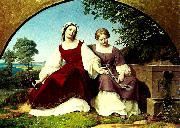 |
e. j. f. bendemann
|
|
Eduard Julius Friedrich Bendemann (3 December 1811, Berlin - 27 December 1889, Dusseldorf) was a German painter.
Bendemann was born in Berlin. His father, Anton Heinrich Bendemann, a Jewish banker, monitored his education closely; it was one that would have naturally led him to some sort of technical occupation, but his talent and propensity towards art resulted in his being allowed to pursue other interests. His mother Fanny Eleonore Bendemann nee von Halle, also a daughter of the Jewish banker Joel Samuel von Halle.
After he completed elementary school he enrolled in the Wilhelm von Schadow's School in Dusseldorf. In 1830 he went on a school trip to Italy. After a series of jobs, among them with Boas and Ruth, his talent as an artist began to show, especially with his very large 1832 painting titled, The Sad Jews of Babylon which was featured in the Berlin art exhibition. The picture garnered a great deal of attention, which was in part due to the deep and simple feeling and the noble composition of the piece (museum in Cologne). Bendemanns second picture: The Two Girls at the Well (1832), was acquired by the North Rhine-Westphalia art association.
Soon thereafter followed Jeremias on the Ruins of Jerusalem for which the artist received a medal in Paris in 1837. This painting was for the most part about the progress of the Jews in Babylon. (Royal Palace in Hanover). His best known work is The Harvest.
The artist's first fresco was a symbolic representation of the art at the Poetry Well at the house of his parents-in-law in Berlin. In the year 1838 he was appointed professor of the academy of arts in Dresden, where he had the opportunity to paint even larger frescos. Bendemann was given the task to decorate three halls of the Dresden royal palace, the throne room, the tower room, and the tower hall with wall paintings. In the throne room, on both sides of the throne, there are representations of important rulers and legislators in gold leaf with smaller representations in relief form below, from Moses up to Albrecht III, the King at the time. On the wall facing the throne there are four paintings depicting events from the life of King Heinrich I each with other pictures attached which explain each of the four events. Bendemann died in Dusseldorf. |
|
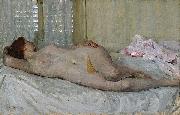 |
E. Phillips Fox
|
|
Emanuel Phillips Fox (1865-1915) was an Australian Naturalist painter.
|
|
|
|
|
|
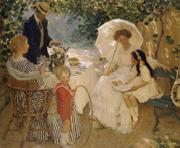 |
E.Phillips Fox
|
|
Australian Naturalist Painter, 1865-1915
Australian painter and teacher. From 1878 to 1886 he trained at the National Gallery of Victoria Art Schools, Melbourne, and in 1887 left to study in Europe. In Paris he attended the Academie Julian and was taught by Jean-Leon Gereme at the Ecole des Beaux-Arts and by the American artist T. Alexander Harrison (1853-1930). He was involved with the plein-air artists at Etaples, Pas-de-Calais, and in Brittany and also visited Giverny, where from 1883 Monet was living. By 1890 he had moved to England, to the artists' colony at St Ives, Cornwall. In 1892 he returned to Melbourne where he chiefly painted portraits and landscapes. He was a member of the Victorian Artists' Society, exhibiting with them between 1892 and 1900. In 1893 he established the lively Melbourne Art School with Tudor St George Tucker (1862-1906). There an academic training coupled with a modified Impressionist technique was taught, as can be seen in Fox's painting the Art Students . In 1901 he left for London, having been commissioned by the Trustees of the National Gallery of Victoria to paint the Landing of Captain Cook at Botany Bay. After his marriage in 1905 to the artist Ethel Carrick, he and his wife settled in Paris and remained there until 1913. |
|
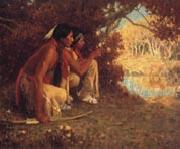 |
Eanger Irving Couse
|
|
American Painter , b.1866 d.1936
was an artist and founding member of the Taos artists colony in Taos, New Mexico. Couse was born in Saginaw, Michigan, where he first started drawing the Chippewa Indians who lived nearby. Couse attended the Art Institute of Chicago, and the National Academy of Design, New York. He left for Paris to study at the Ecole des Beaux-Arts and Academie Julian under Bouguereau. He lived in France 10 years, where he painted charming scenes of the Normandy coast. After his return to America he devoted himself to depicting the life and habits of the Taos Indians, a pueblo tribe in New Mexico. He reveals the poetical and philosophical rather than the savage and warlike side of the Indians, and his skillfully executed pictures are full of sentiment. |
|
|
|
 |
Eastman Johnson
|
|
American portrait and genre painter, 1824-1906
American painter and printmaker. Between 1840 and 1842 he was apprenticed to the Boston lithographer John H. Bufford (1810-70). His mastery of this medium is apparent in his few lithographs, of which the best known is Marguerite (c. 1865-70; Worcester, MA, Amer. Antiqua. Soc.). In 1845 he moved to Washington, DC, where he drew portraits in chalk, crayon and charcoal of prominent Americans, including Daniel Webster, John Quincy Adams and Dolly Madison (all 1846; Cambridge, MA, Fogg). In 1846 he settled in Boston and brought his early portrait style to its fullest development. His chiaroscuro charcoal drawings, of exceptional sensitivity, were remarkably sophisticated for an essentially self-trained artist. In 1848 he travelled to Europe to study painting at the D?sseldorf Akademie. During his two-year stay he was closely associated with Emanuel Leutze, and painted his first genre subjects |
|
 |
Ebenezer Colls
|
|
(1812- 1887 ) - Painter
painted Sailboats in a squall in |
|
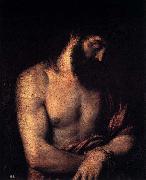 |
Ecce Homo
|
|
are the Latin words used by Pontius Pilate in the Vulgate translation of the John 19:5, when he presents a scourged Jesus Christ, bound and crowned with thorns, to a hostile crowd shortly before his Crucifixion. The King James Version translates the phrase into English as Behold the Man. The scene is widely depicted in Christian art.
The Ecce homo is a standard component of cycles illustrating the Passion and Life of Christ in art. It follows the Flagellation of Christ, the Crowning with thorns and the Mocking of Christ, the last two often being combined. The usual depiction shows Pilate and Christ, the mocking crowd and parts of the city of Jerusalem.
But, from the 15th century, devotional pictures began to portray Jesus alone, in half or full figure with a purple robe, loincloth, crown of thorns and torture wounds, especially on his head. Similar subjects but with the wounds of the crucifixion visible (Nail wounds on the limbs, spear wounds on the sides), are termed a Man of Sorrow(s) (also Misericordia). If the "Instruments of the Passion" are present, it may be called an Arma Christi. If Christ is sitting down (usually supporting himself with his hand on his thigh), it may be referred to it as Christ at rest or Pensive Christ. It is not always possible to distinguish these subjects.
|
|
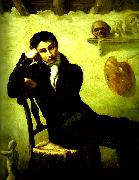 |
ecole francaise
|
|
Founded in 1846, the EfA is the oldest foreign institute in Athens. Its early foundation, still a source of considerable prestige, is to be seen culturally connected with French philhellenism and politically with the French East Mediterranean strategy of the time.
|
|
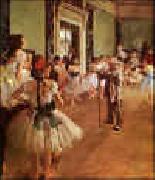 |
Edgar Degas
|
|
French Realist/Impressionist Painter and Sculptor, 1834-1917
French painter, draughtsman, printmaker, sculptor, pastellist, photographer and collector. He was a founder-member of the Impressionist group and the leader within it of the Realist tendency. He organized several of the group exhibitions, but after 1886 he showed his works very rarely and largely withdrew from the Parisian art world. As he was sufficiently wealthy, he was not constricted by the need to sell his work, and even his late pieces retain a vigour and a power to shock that is lacking in the contemporary productions of his Impressionist colleagues. |
|
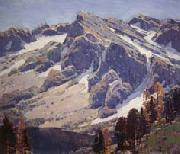 |
Edgar Payne
|
|
American Painter, ca.1882-1947
was an American Impressionist painter best remembered for his impressionist landscapes. Born in Chicago, Illinois, his art education included training at the Art Institute of Chicago (where he enrolled at Saturday classes at the age of 11), the Art Students League of New York, and in the atelier of William Merritt Chase. He spent much of his early career working in Paris, France. He served in the US Army as an aerial photographer during World War I. [1]In 1920 he and his wife relocated to Pasadena, California. He taught fine art at Occidental College, and was director of the Stickney Memorial School of Art in Pasadena. |
|
|
|
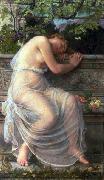 |
Edith Corbet
|
|
(28 December 1846 Goulburn, New South Wales - 1920 Hampstead), was a Victorian landscape painter, having close associations with the Macchiaioli group (also known as the Tuscans or Etruscans), who, in a break with tradition, painted outdoors in order to capture natural light effects and favoured a panoramic format for their paintings.
Edith was born in Goulburn, New South Wales, Australia, the second daughter and fifth child of Henry Edenborough and Margaret Stedman. The Edenborough family came from Leicestershire, but relocated to London, where they became prosperous merchants in hosiery and silk. Henry Edenborough was a sea captain and made several voyages to Australia between 1833 and 1837, deciding to settle there in 1840. He acquired a farm south of Goulburn known as 'Wollogorang' and built "a handsome two-storey brick and stone rubble building notable for its interesting French windows and its impressive outbuildings". This was the family home until 1854 when Henry and Margaret sold the property to John William Chisholm, and returned to England with their family of six children. Henry died in 1855 at Chesham Lodge in Surrey, aged 43. In 1861 the British census records show Edith, 14 years old, living with her widowed mother in Kensington. The 1871 census shows her living with her sister Annie, noted as head of household, at 5 Sheffield Gardens in Kensington, in which year she was exhibiting her work in London.
She married the painter Arthur Murch and moved to Rome where she painted with Giovanni Costa, leader of the Macchiaioli group. In 1876 they both stayed in Venice. Olivia Rossetti Agresti wrote: "Costa had a very high opinion of this artist's gifts and used to remember with pleasure how on that occasion they used to go out together to paint from nature at Fusino" (Agresti, 1904).
Edith Murch frequently exhibited from 1880 to 1890 at the Grosvenor Gallery and the New Gallery. In 1891 she married Matthew Ridley Corbet, one of the Macchiaioli group's leading members, after which she exhibited mainly at the Royal Academy, visiting Italy and living in London for the remainder of her life.
|
|
|
|
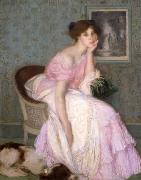 |
Edmond Aman-Jean
|
|
(1858 - 1936) was a French symbolist painter, who founded the Salon des Tuileries. It is also noted that he was a friend of Georges Seurat. |
|
 |
Edmund Blair Leighton
|
|
1853-1922
British
Leighton was the son of the artist Charles Blair Leighton. He was educated at University College School, before becoming a student at the Royal Academy Schools. He married Katherine Nash in 1885 and they went on to have a son and daughter. He exhibited annually at the Royal Academy from 1878 to 1920.
Leighton was a fastidious craftsman, producing highly-finished, decorative pictures. It would appear that he left no diaries, and though he exhibited at the Royal Academy for over forty years, he was never an Academician or an Associate. |
|
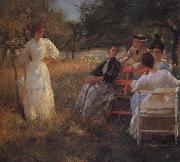 |
Edmund Charles Tarbell
|
|
American Impressionist Painter, 1862-1938
American painter, illustrator and teacher. He attended drawing lessons at the Normal Art School, Boston, MA, and art classes with W. A. G. Claus. From 1877 to 1880 he was apprenticed to a lithographic company in Boston. In 1879 Tarbell entered the School of the Boston Museum of Fine Arts, where he was a pupil of Otto Grundmann (1844-90), a former student of Baron Hendrik Leys in Antwerp. In 1883 Tarbell left for Paris with his fellow student Frank W. Benson. Both Tarbell and Benson attended the Acad?mie Julian, where they studied with Gustave Boulanger and Jules Lefebvre. They travelled to Italy in 1884 and to Italy, Belgium, Germany and Brittany the following year. Tarbell returned to Boston in 1886. Initially after his return, Tarbell made a living from magazine illustration, teaching privately and painting portraits. In 1889 Tarbell and Benson took Grundmann's place at the Museum School. |
|
|
|
|
|
|
|
|
|
|
|
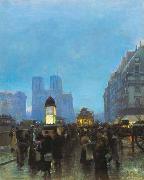 |
Edmund Tull
|
|
(1870 - 1911) was a Hungarian artist born at Szekesfeherver. He was educated at Budapest, Milan, and Paris, being in the last-named city a pupil of J. P. Laurens and of B. Constant. His first work, "The Cathedral of Notre Dame," attracted attention at the exposition in Budapest in 1896, while his etchings are especially valued in London and Vienna. His best-known works are: "Peasant Mowing," "A Lane in Dort," and "The Island of Capri," in the historical art museum of Budapest; and "The Smithy," owned by Archduchess Isabella.
|
|
|
|
|
|
 |
Edouard Castres
|
|
Swiss 1838 - 1902
Swiss painter. His father was a clock engraver, and he initially trained as an enamellist. He took drawing lessons from Barthelemy Menn and attended the Ecole des Beaux-Arts in Paris from 1859. He soon decided to concentrate on oil painting. He was assistant to the genre and figure painter Eduardo Zamacois y Zabala (1842-71). In the Franco-Prussian War he joined the Red Cross, moving into Switzerland at the beginning of February 1871 with the army led by Gen. Bourbaki. He painted military scenes from sketches carried out on the battlefield and received consistently good reviews, which also brought financial success. He was commissioned by a Belgian panorama company to record the entry of the French army into Switzerland, which he had witnessed in 1871. He spent the winter of 1876-7 on site at Les Verrieres, painting preparatory studies, and in 1881 he completed the panorama, Gen. Bourbaki's Army Retreating into Switzerland (Lucerne, Panorama). He was aided by nine assistants, recruited from among Menn's pupils, who included Ferdinand Hodler. The work was exhibited in Geneva and was brought to a rotunda in Lucerne in 1889. Among panorama paintings it is a work of a high order: despite the colossal dimensions and the barely comprehensible mass of people depicted, the dominant impression is of individual suffering. |
|
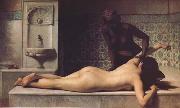 |
Edouard Debat Ponsan
|
|
French Academic Painter, 1847-1913
1847-1913.French painter. He trained in Toulouse and later at the Ecole des Beaux-Arts in Paris under Alexandre Cabanel. In 1873 he won second place in the Prix de Rome and in 1874 the Prix Troyon of the Institut. From the Institut he received a bursary that enabled him to visit Italy. In 1870 he made his debut at the Salon under the name Ponsan-Debat and afterwards exhibited there such genre and history paintings as Jephthah's Daughter (1876; Carcassonne, Mus. B.-A.). He also executed religious works, some of which were for churches and cathedrals: he painted St Paul before the Areopagus (1877) for the church at Courbevoie and the Pity of St Louis for the Dead (1879) for the cathedral at La Rochelle. From 1880 Debat-Ponsan was the name under which he exhibited. The Massage (1883; Toulouse, Mus. Augustins) shows a white female nude massaged by a negress, and the subject attracted comment from contemporary critics. He also painted a number of landscapes, including Corner of the Vineyard (1888; Nantes, Mus. B.-A.). These were painted in a style similar to that of Jules Bastien-Lepage and, when they included figures, were often sentimental. His reputation depended, however, on his portraits, which are distinguished by their vigorous colour and precision, as seen in the portrait of Pouyer-Quertier (c. 1885; Rouen, Mus. B.-A.). Most notable was his portrait of General Boulanger (1887; untraced), which was shown at the Salon of 1887 and was accepted in 1889 for the Exposition Universelle in Paris. Amid scandal, Debat-Ponsan withdrew it soon after the opening because he thought that the Exposition was badly organized and his painting was not shown to advantage. He refused the bronze medal awarded it by the jury. In later years, while producing such paintings as Christ on the Mountain (1889; Toulouse, Mus. Augustins), he increasingly responded to contemporary events in his work. |
|
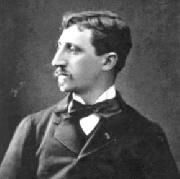 |
Edouard Detaille
|
|
(October 5, 1848 - December 23, 1912), was a French Academic painter and military artist noted for his precision and realistic detail.
Detaille was a student of Jean-Louis-Ernest Meissonier. He served in the French Army in the Franco-Prussian War of 1870-1871 and became the official painter of the battles. He is famous for his portraits of soldiers and depictions of military manoeuvres, military uniforms and general military life. |
|
|
|
|

